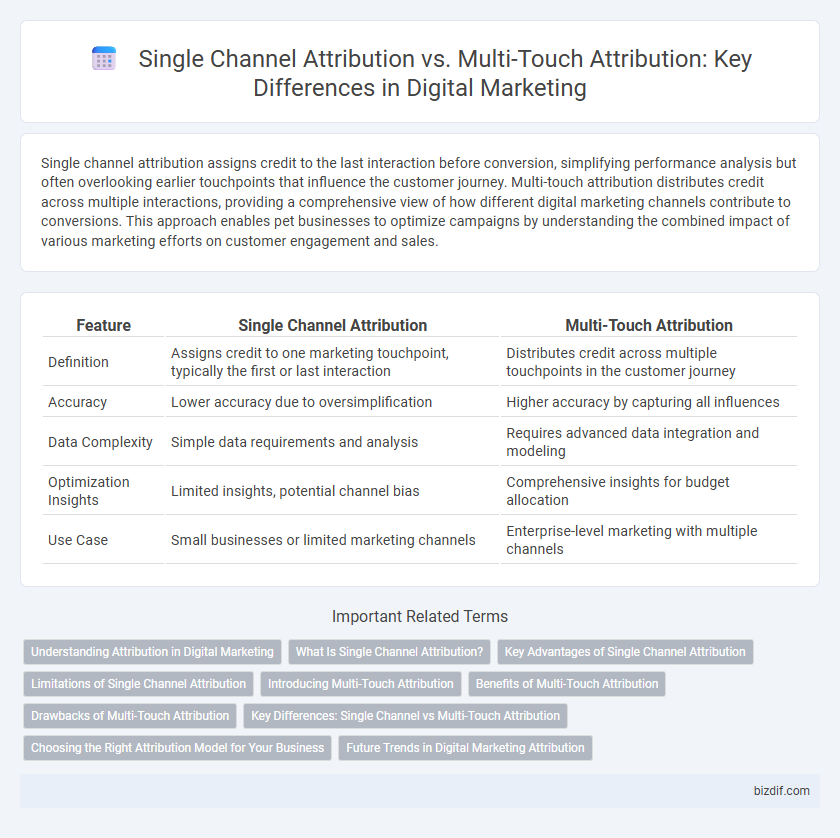Single channel attribution assigns credit to the last interaction before conversion, simplifying performance analysis but often overlooking earlier touchpoints that influence the customer journey. Multi-touch attribution distributes credit across multiple interactions, providing a comprehensive view of how different digital marketing channels contribute to conversions. This approach enables pet businesses to optimize campaigns by understanding the combined impact of various marketing efforts on customer engagement and sales.
Table of Comparison
| Feature | Single Channel Attribution | Multi-Touch Attribution |
|---|---|---|
| Definition | Assigns credit to one marketing touchpoint, typically the first or last interaction | Distributes credit across multiple touchpoints in the customer journey |
| Accuracy | Lower accuracy due to oversimplification | Higher accuracy by capturing all influences |
| Data Complexity | Simple data requirements and analysis | Requires advanced data integration and modeling |
| Optimization Insights | Limited insights, potential channel bias | Comprehensive insights for budget allocation |
| Use Case | Small businesses or limited marketing channels | Enterprise-level marketing with multiple channels |
Understanding Attribution in Digital Marketing
Single channel attribution assigns credit for a conversion to one touchpoint, simplifying the analysis but potentially overlooking the complexity of customer journeys. Multi-touch attribution provides a more comprehensive view by distributing credit across all interactions, helping marketers optimize campaigns based on the full user experience. Understanding these models is crucial for accurately measuring ROI and allocating budget effectively in digital marketing strategies.
What Is Single Channel Attribution?
Single channel attribution assigns credit for a conversion to one specific marketing touchpoint, such as a paid search ad or an email campaign, providing a clear view of performance for that single channel. This model simplifies analysis by focusing on direct response data, making it easier to measure ROI for individual campaigns. However, it may overlook the influence of other interactions along the customer journey, limiting a comprehensive understanding of overall marketing effectiveness.
Key Advantages of Single Channel Attribution
Single Channel Attribution simplifies performance analysis by assigning conversion credit to one specific marketing channel, offering clear insights into the effectiveness of individual campaigns. This model is easier to implement and interpret compared to Multi-Touch Attribution, reducing complexity and data management challenges. Brands benefit from faster decision-making and budget allocation by focusing on the most impactful single-source interactions.
Limitations of Single Channel Attribution
Single Channel Attribution often overlooks the complexity of customer journeys by assigning all credit to the last interaction, leading to skewed insights and inefficient budget allocation. This model fails to capture the influence of multiple touchpoints across various channels, resulting in underestimated value for upper-funnel marketing efforts like social media and display ads. Consequently, marketers using Single Channel Attribution risk making decisions based on incomplete data, which can hinder the optimization of multi-channel digital marketing strategies.
Introducing Multi-Touch Attribution
Multi-Touch Attribution provides a comprehensive analysis of customer interactions by assigning credit to all touchpoints in the conversion journey, unlike Single Channel Attribution which only credits the last interaction. By tracking multiple channels such as email, social media, and paid search, Multi-Touch Attribution delivers deeper insights into the effectiveness of each marketing effort. This approach enhances budget allocation, improves campaign optimization, and drives higher return on investment in digital marketing strategies.
Benefits of Multi-Touch Attribution
Multi-Touch Attribution provides a comprehensive view of customer interactions across various touchpoints, enabling more accurate allocation of marketing budget. This approach improves campaign performance by identifying the true impact of each channel, from social media ads to email marketing and search engine optimization. Brands leveraging Multi-Touch Attribution gain valuable insights that drive better decision-making and maximize return on investment (ROI).
Drawbacks of Multi-Touch Attribution
Multi-Touch Attribution models can introduce complexity and data inaccuracies due to the necessity of tracking multiple touchpoints across various digital channels, often leading to fragmented or incomplete customer journey data. High implementation costs and the demand for advanced analytics capabilities create barriers for many businesses lacking sufficient resources or technical expertise. Furthermore, overemphasis on certain touchpoints can result in misallocation of marketing budgets, reducing overall campaign effectiveness.
Key Differences: Single Channel vs Multi-Touch Attribution
Single channel attribution assigns credit to one marketing touchpoint, often the last click, simplifying analysis but potentially overlooking the full customer journey. Multi-touch attribution distributes credit across multiple interactions, offering a comprehensive view of how different channels collectively influence conversions. Understanding these key differences enables marketers to choose between streamlined insights or a detailed, data-driven approach for optimizing campaigns.
Choosing the Right Attribution Model for Your Business
Selecting the right attribution model depends on your business goals and customer journey complexity. Single channel attribution offers simplicity by assigning credit to one touchpoint, ideal for straightforward sales cycles and niche markets. Multi-touch attribution provides a comprehensive view by distributing credit across multiple interactions, enhancing insights for businesses with diverse marketing channels and longer sales funnels.
Future Trends in Digital Marketing Attribution
Future trends in digital marketing attribution emphasize advanced multi-touch attribution models leveraging AI and machine learning to deliver precise insights across complex customer journeys. Increasing adoption of data-driven attribution will enable marketers to allocate budgets more effectively by tracking interactions across multiple channels and devices. Enhanced privacy regulations and the rise of first-party data will drive innovation in attribution methodologies, ensuring compliance while maintaining accurate performance measurement.
Single Channel Attribution vs Multi-Touch Attribution Infographic

 bizdif.com
bizdif.com